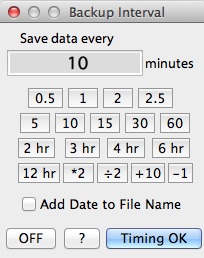| Timed data backups
|
TIMED DATA SAVES | ⌘T This option sets up an automatic backup function during data acquisition
runs, which helps safeguard data from program or system crashes, power failures,
and other potential catastrophes. At very high sampling rates and
short acquisition periods, automatic backup is of limited |  utility (and can actually slow your acquisition speed), but
it can be a lifesaver if you need to sample over long periods -- especially
if the computer must be left unattended. utility (and can actually slow your acquisition speed), but
it can be a lifesaver if you need to sample over long periods -- especially
if the computer must be left unattended.
To turn on automatic file saving, you need to specify the 'backup interval" between saves. Obviously, the shorter the interval, the greater the protection. However, it takes some time to save data (not much if you are saving in binary format), and at high sample rates this can slow acquisition. The LabHelper default is to use a saving interval equal to 50% of the expected acquisition period (i.e., the sample interval times the maximum number of samples), or 30 minutes, whichever is smaller. You can use the window shown at right to specify any backup interval, or to switch off automatic backup. If automatic file saving is operating, a gray menu ("backup ON") appears, and as backups occur this menu is incremented (i.e., "backup 1", then "backup 2", etc.). The data are saved in the current folder. By default they are named "backup file" and (optionally) have the current date appended (i.e., "backup file 10/10/2019"). Although 'Backup' is the default, when you are asked for a backup file name, you can chose any name you like. As a safety precaution, LabHelper stores TWO backups, one of which is always called "Primary backup.whog". Sequential backups will overwrite each other, but if the date is appended a new backup name will be used when the date changes at midnight. If acquisition concludes normally, you can save the complete set of data under any name you wish, and the backup file(s) can be disposed of.
|